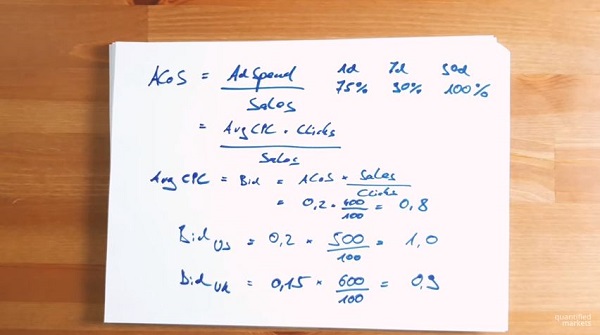What is the ideal ACoS for my Amazon PPC campaigns?
As an Amazon seller, one of your most important KPIs is your ACoS. What is the ACoS, and what do you need to know about it?
In this article, we will help you understand your Amazon ACoS as well as how your industry and product lifecycle might affect your target ACoS. But before we dive into the details let’s talk about the definitions and the pitfalls many sellers are not aware of.
What does ACoS stand for?
ACoS stands for Advertising Cost of Sales and is simply calculated by dividing your marketing cost by the revenue generated by your ads.
ACoS = Advertising Cost / Attributed Revenue
When people speak about their ACoS, they are usually referring to the ACoS of a particular campaign or their overall ACoS. If you want to be more precise, you can calculate your ACoS more granularly at the ad group, product ad, and/or keyword level.
As you can see, the definition of cost is fairly straightforward:
Cost = Number of Clicks * Cost Per Click
But “attributed revenue” is a bit more complicated because Amazon provides six different sales figures. The two differentiating features of these sales figures are:
- Attribution window
- Same-SKU-sales vs. total sales
Attribution window:
Understanding the attribution window is important for helping determine revenue. The attribution window is the maximum time between a click and an order. Amazon provides data on three different attribution windows:
- 1-day
- 7-day
- 30-day
So, which value should you use in calculating? That depends on what you want to measure.
- Measuring direct response
Do you want to know if your customer made a purchase after clicking on your ad? Then you want to measure direct response, and you should select the 1-day attribution window, since people have short attention spans – especially when it comes to online shopping.
- Measuring economic value
Are you more interested in knowing the economic value your ads created? Then you should select the 7-day or 30-day attribution window. The 30-day is the maximum attribution window, so the 30-day revenue reflects 100% of your measurable sales. On average, the 1-day attribution window is 75% of those sales and the 7-day window is 90% of those sales.
In case you are curious, the reported revenue in the campaign manager of Amazon Seller Central uses the 7-day attribution window.
You can probably see there are good arguments for choosing each of the attribution windows. Consequently, there is no right or wrong value—or choice. What you do need to keep in mind is that your target ACoS should be defined based on the attributed window you’ve selected. How does this work?
If you’ve chosen a longer attribution window, you are associating more sales (ultimately) with the same cost, and so your ACoS will be lower. Given a longer attribution window, the defined maximum ACoS should be lower. On the other hand, if you’re using a shorter attribution window, your ACoS will be higher. See how that works?
Same-SKU vs. Total Sales
Let’s talk about the other aspect mentioned above. Amazon differentiates between Same-SKU Sales and Total Sales. To illustrate how this works, whenever a customer orders one of your products after clicking on one of your ads, the revenue is attributed to your total sales.
If the customer orders the exact product advertised, the revenue is only attributed to your Same-SKU sales. If your customer, however, orders a different product variation, the sale is not attributed to your Same-SKU sales. If you have a lot of product variations, you have to understand that your Same-SKU sales are just a tiny fraction of your total sales. This is very true, for example, in apparel products—because often you have an array of different sizes, colors, and styles of product.
So which value should you choose? That depends. If your goal is to sell a specific product, thereby managing your inventory and avoiding long-term storage fees, you should work with the Same-SKU sales. If you instead want to measure the created economic value, you should work with the Total Sales number.
One mistake sellers often make is in interpreting the ACoS of new campaigns. When sellers create new campaigns, they are quite often shocked by their very high ACoS. There is no need to be shocked; just be sure you’re not misinterpreting the ACoS. As Amazon states in the documentation, all campaign performance data is usually reported within 48 hours. After those 48 hours your advertising cost is known, but what about the attributed sales? As mentioned above, the Seller Central calculates with the 7-day attribution window, so after 48 hours, your attribution window is still incomplete. As a result, your ACoS will be much higher than expected. Let’s illustrate this with an example: say you want to interpret the traffic generated on January 1st. In this case you would have to wait until January 10th (January 1st + 7-day (attribution window) + 48 hours (time Amazon takes to provide all data)) to have reliable data.
Importance of ACoS
Why is the ACoS so important? Its primary function is to measure the efficiency of your PPC campaigns. Reducing advertising cost or increasing PPC sales leads to an increase in marketing efficiency – and a lower ACoS. Additionally, the ACoS indirectly represents the profitability of your paid advertising.
You might be wondering if it makes sense to compare your ACoS to the ACoS of other sellers. In short, the answer is no.
Why? Your ACoS very much depends on your product category, your corporate goals (whether those goals are about growth or profitability) and the efficiency of your campaign management. These factors differ radically between sellers. To show you how and why, let’s compare.
Brand-dominated categories require a specific strategy. For example, perfumery is dominated by traditional brands that often distribute their products via retailers. Retailers usually have an EBIT of around 7% and, consequently, their marketing budget is very limited. Additionally, consumer behavior around keywords is specific. Consumers are searching for specific brands and brand-related keywords and, because of this, keywords have a fairly high conversion rate. With a limited budget and low click prices, ACoS is usually very low – around 3%.
Private label product categories offer sharp contrast. Let’s consider garlic presses, for instance. Traditional brands’ market share is comparatively low, and the net margin of direct-to-consumer sellers is significantly higher. Because of this, click prices and ACoS are much higher as well. ACoS in this category might be 25% – far higher, but perhaps profitable and strategically desirable.
Calculating your maximum ACoS
 Instead of sniffing around, you can benchmark on your own. To calculate your individual maximum ACoS, we have to start with the breakeven condition. Your marketing is breakeven when your cost per order equals your net profit margin.
Instead of sniffing around, you can benchmark on your own. To calculate your individual maximum ACoS, we have to start with the breakeven condition. Your marketing is breakeven when your cost per order equals your net profit margin.
Cost Per Order = Net Profit Margin
The cost per order is total marketing cost divided by the number of orders generated:
Cost/Attributed Conversions = Net Profit Margin
Net-Profit-Margin is the gross order value reduced by all non-marketing costs. Exclude the marketing cost from the net profit margin, as our goal is to calculate the maximum cost we can generate in order to be breakeven. While your individual cost structure might differ, a good starting point is:
Net Profit Margin = Gross Product Price – VAT – purchase Price – packaging Costs – shipping Costs – transaction Fees
Here is a breakdown of the costs:
- The gross product price is what the customer pays for your product, including the shipping costs the customer pays.
- VAT is the value added tax.
- The purchase price is the net price you buy the product for. For manufacturers, the purchase price equals your production costs.
- Packaging costs are the costs for product package (if not part of the purchase price) and repackaging.
- Shipping costs are the costs for shipping the product from the warehouse or fulfillment center to the customer. If you are using Fulfillment by Amazon (FBA) shipping costs equal your FBA fees.
- Transaction costs are the Amazon Referral fees
We can now rearrange the break-even condition in order to calculate the maximum ACoS:
Cost Per Order = Net Profit Margin
Cost / Attributed Conversions = Gross Product Price – VAT – purchase Price – packaging Costs – shipping Costs – transaction Fees
We multiply this by (1/Average Basket):
(Cost / Attributed Conversions) * (1/Average Basket) = (Gross Product Price – VAT – purchase Price – packaging Costs – shipping Costs – transaction Fees) /Average Basket
Now (Cost / (Attributed-Conversions* Average-Basket)) equals (Cost / Attributed-Sales) which is our ACoS formula.
ACoS = (Gross Product Price – VAT – purchase Price – packaging Costs – shipping Costs – transaction Fees) /Average Basket
The average basket differs from the gross product price when customers regularly order quantities of more than one or when they regularly order multiple products. As long as this is not a major concern, you can simplify the formula:
ACoS = (Gross Product Price – VAT – purchase Price – packaging Costs – shipping Costs – transaction Fees) / Gross Product Price
As the average basket is by definition larger than or equal to the gross product price, the simplified formula is a “conservative estimate” and consequently often contains a safety-profit-buffer.
Going back to breakeven, what does this mean? If your Sponsored Products ACoS equals the calculated maximum ACoS, your ads are breakeven. You don’t lose money and you don’t earn money with your ads. Seeking profitability? Reduce your maximum ACoS by multiplying with a factor of less than 1.
Your goal will depend on where in the product life cycle stage your product is. You could be aiming for profitability or for generating reach and awareness, and it all depends on your place in the cycle. If you’re launching a new product, it is wise to make an investment in the beginning of your PPC campaigns—and be prepared to take losses for some time—to generate valuable data that will drive long-term growth and profits. To learn more about PPC strategy according to your specific product life cycle, you can find our strategy blueprint here.
You will find many of the mentioned topics in this article also in my video about bid management process. For example: How to define your ACoS, the six different sales figures, total sales vs. same-SKU-sales and much more interesting information.
Do you have questions, or would you like us to check your current campaign parameters? Please feel free to contact us or comment below. We are always glad to help.
This post is also available in: German




I am an Amazon seller from the Netherlands. This is very interesting. Didn’t see this perspective before. Thank you!
Hi Ryan,
thank you very much for your kind words. I’m wishing you all the best for your Amazon business.
Kind regards,
Michael